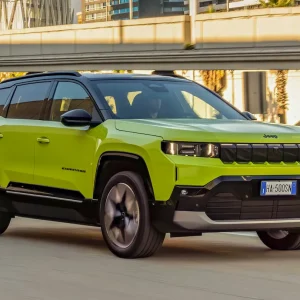The superlatives for the BMW X5 come easy as well as thick and fast. The first real sporty large 4×4 to arrive in showrooms, it’s no exaggeration to say that the X5 was a game-changer when it first arrived in 1999.
More than 2.2 million worldwide sales later and we now have this fourth-generation X5 boasting even better luxury and performance as well as improved off-road ability. But this new model arrives into a very different market for BMW. After all, the smaller X3 is now actually bigger than that first-generation X5, while the even larger X7 will go on sale in spring 2019.
Thinking big
So it’s little surprise that this new X5 is longer, wider and taller than its predecessor, to remain positioned between the X3 and forthcoming X7. The oversized grille isn’t to everyone’s taste (although we don’t mind it too much) but the rear end looks a little anaemic to our eyes, with its narrow lights not entirely unlike the old Jeep Grand Cherokee.
BMW expects 30% of X5 buyers to be businesses and, historically, the X5 has always attracted a high percentage of user-choosers. By comparison, that’s about half the comparable figure on the 5 Series. This 30d engine version of the X5 is expected to account for around two thirds of all sales, although it’s an indicator of the diesel downturn that BMW expects the 3.0-litre turbo-petrol 40i to take a quarter of sales, the remainder being taken by the flagship 400hp 50d model.

Company car drivers will be sure to keep an eye on the X5’s expanded engine line-up due in summer next year though, as that will include a plug-in hybrid badged as 45e alongside a 40d diesel and a 50i petrol. The arrival of the plug-in hybrid is expected to more than double that level of business drivers.
This initial 30d is still mightily impressive though with 265bhp under the driver’s right foot and a 0-62mph time of 6.5 seconds along with a 143mph top speed. At the pumps, it returns a 47.1mpg average with 158g/km CO2 emissions, placing it in the 36% BIK tax band.
Sit back and relax
On the road, the X5’s refinement levels are nothing short of superb. The ride quality, even on the larger, optional 21in wheels is excellent, and there’s only a small amount of tyre and wind noise at motorway speeds. The engine is quiet, even at higher revs when driving harder, and while you’re never less than aware of the new X5’s larger dimensions, it handles its size relatively well. Even when encountering difficult, off-camber rises halfway through a bend, the X5’s weight is obvious (up 40kg from before) but it quickly settles down and there’s no further deflection on the air suspension that can befall some cars.
Despite pretty good handling and a lack of body roll through bends, this fourth-generation X5 has lost some of its sharpness in favour of that more mature and comfortable feel. The steering is accurate enough, but it could do with more consistency in its weighting as well as more feel about what the car is doing beneath you. It isn’t that it’s especially bad, it’s just that it’s not the sportier choice that it once was.
Quality cabin
Ironically, that’s not helped by the driving position which, while comfortable, never feels quite low enough even in its lowest setting. That’s the only demerit though in what is an otherwise exceptional interior – from its build quality to the materials used, it’s hard to fault.

Aesthetically though, there are a few hits and misses. We love the metal knurling on some of the controls including the rotary iDrive controller and the mirrored finish on top of the controller is smart, but the multifaceted Swarovski crystal gear selector looks way too ostentatious. Plus, we’re still not convinced about the gesture control system (as also seen on the 5 and 7 Series), as it’s far too easy to set off if moving your hands while talking to a passenger. We love the heated and cooled cupholders though.
Flooding the cabin with light is the new panoramic glass roof, which is now 30% larger than before, and there’s an option for 15,000 lights within the glass to give it a night sky effect like the Rolls-Royce Phantom. The middle row of seats can slide and recline electrically, and have plenty of head and legroom; that’s just as well given that the third row pair of seats (a £1,390 option chosen by around half of all buyers) are otherwise strictly for teenagers or younger.
There’s a decent-sized boot too at 645 litres (1,860 with the rear seats down), which is also accessed by an electric split tailgate. BMW’s engineers said they kept this split tailgate as a direct result of positive feedback from buyers (it can also take a 250kg load) – an interesting fact when Land Rover dropped this layout for the current Discovery.
The new X5 is arguably now more well-rounded than ever, but then it needs to be in a market now packed with talent. With a new Mercedes GLE on the way, plus the latest Lexus RX450L, and the talented Volvo XC90 and Land Rover Discovery, there’s not really a short straw anywhere in the sector. Just as well then that this is probably the best X5 ever and, 19 years on from that game-changing original, remains one of the best choices in this class.
P11D: £56,610
On sale: Now
Residual value: 47%
CO2 (BIK band): 158g/km (36%)
Boot space: 645 litres
Engine size/power: 2,993cc, 265hp





